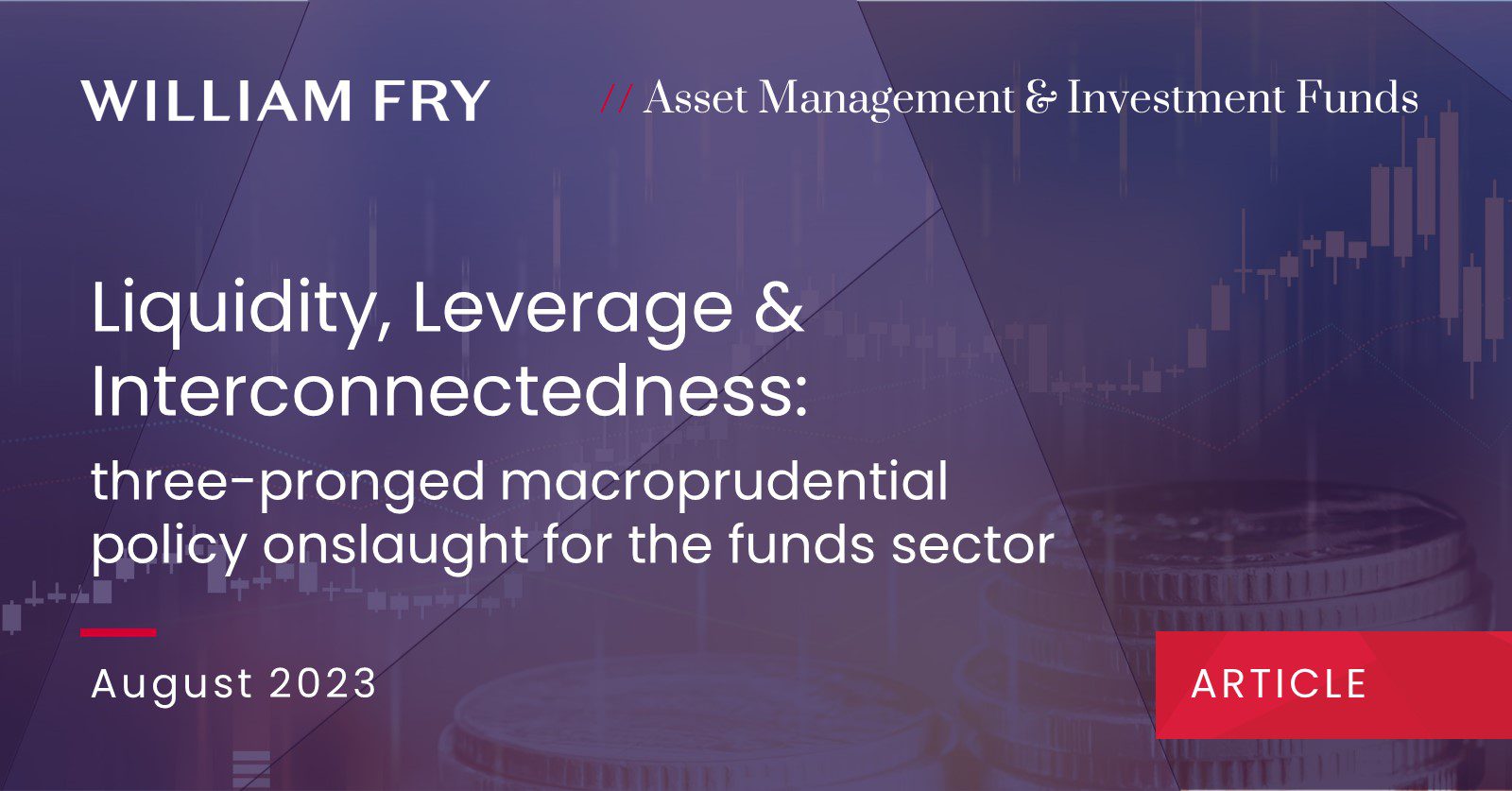John Schindler, the Secretary General of the Financial Stability Board (FSB), delivered a speech last month on financial headwinds.
Perhaps unsurprisingly, given the ever-increasing financial stability-driven focus of policymakers on the funds sector, the speech focussed almost exclusively on non-bank financial intermediation (NBFI), AKA shadow banking, a broad heterogeneous sector of which investment funds is a key component.
While better known for its banking reform agenda, Mr Schindler submits that NBFI has been a focus of the FSB from its earliest days. But now that global regulatory reforms have increased the resilience of the banking sector, the FSB is emphatically focussed on the key vulnerabilities associated with leverage, liquidity and interconnectedness in NBFI; vulnerabilities which the FSB sees as common to both banks and non-banks.
There are many stakeholders of the funds sector, however, who would dispute the likening of NBFI to the banking sector. In a recent letter to the Financial Times, Bryan Corbett, President and Chief Executive of the Managed Funds Association in the US highlights several key differences, which many consider relevant beyond the US: ‘funds are not implicitly or explicitly backstopped by the federal government’; unlike funds ‘banks have depositors who can withdraw their money at any time’ and if a fund ‘fails, the losses are borne by that specific fund’s investors and do not impact investments in other funds’. Mr Corbett concludes noting that ‘policymakers should focus on the banking crisis at hand and resist using current circumstances as a stalking horse to impose stricter regulations on a non-systemically risky industry’.
In light of recent macroprudential developments in the funds sector (summarised below), however, it seems policymakers’ minds are made up and as noted by the Governor of the Central Bank of Ireland when launching its discussion paper on a macroprudential framework for investment funds “Macroprudential policy can achieve [resilience] by preventing the build-up of excessive vulnerabilities across relevant cohorts of the funds sector and/or limit the potential for the sector to amplify adverse shocks through its interconnectedness with other parts of the financial system.”
A Macroprudential Framework for Investment Funds
Discussion paper published by Central Bank of Ireland on 18 July 2023
Similar to the FSB, the financial stability concerns of the Central Bank of Ireland (the Central Bank), as highlighted in its discussion paper, stem from (i) the size and significant growth of the funds sector, (ii) Ireland’s status as one of the largest hubs globally for investment funds and (iii) the absence of high-quality data which would allow for meaningful analysis of the resilience of the funds sector to market shocks.
While the Central Bank’s discussion paper does not propose specific policy measures, it does detail potential macroprudential tools for addressing the perceived key risk factors of leverage, liquidity, and interconnectedness.
In the case of liquidity, the discussion paper notes that these measures may include more prescriptive regulatory rules to reduce dealing frequencies, widen redemption notice periods for less liquid funds, introduce liquid asset buffers for specific fund cohorts, require use of (price/quantity-based) liquidity management tools (LMTs) and require fund stress testing to take account of wider financial stability matters.
To manage leverage levels in funds, the Central Bank favours leverage limits although notes the operational challenges associated with their calibration and design. Regulators’ long-time issue with measuring leverage generated by derivatives is noted along with the challenge this creates for regulators’ understanding and analysis of the levels of leverage actually in the system. A situation which the Central Bank notes may benefit from enhanced regulatory stress testing.
Potential tools targeting interconnectedness outlined in the discussion paper include a form of the position-driven concentration limit already in place in the EU under MiFID which could be adapted to apply to certain types of investment funds. Another potential option tabled by the Central Bank for discussion is to apply margin rules, currently in place for OTC derivatives under EMIR, to investment funds which could be triggered/increased in the event of deemed systemic risk from a particular cohort of funds.
The feedback period for the Central Bank’s discussion paper is open until 15 November 2023.
Policies to address vulnerabilities from liquidity mismatch in open-ended funds
FSB Consultation published on 5 July 2023
The FSB is consulting on updates to its 2017 Policy Recommendations to Address Structural Vulnerabilities from Asset Management Activities. Key updates, directed at open-ended funds, include:
- Recommendation 3 – recommends a bucketing approach, whereby funds would be grouped into categories e.g., ‘liquid, illiquid or less liquid’, depending on the liquidity of underlying assets with each category subject to specific expectations in terms of redemption terms and conditions. For example, funds in the liquid category (i.e., which invest >50% in liquid assets) could be daily dealing, those in the illiquid category (i.e., with >30% in illiquid assets) should have a lower than daily frequency and/or longer notice/settlement periods, and those in the less-liquid category (i.e., with >50% in less liquid assets) could be daily dealing subject to the use of anti-dilution LMTs.
- Recommendation 4 – recommends regulators ensure the availability of a broad set of anti-dilution and quantity-based LMTs for use by fund managers in normal and stressed market conditions.
- Recommendation 5 – recommends regulators ensure availability and use of anti-dilution LMTs, in both normal and stressed market conditions, to mitigate the potential first-mover advantage from structural liquidity mismatch by imposing on redeeming investors the costs of liquidity associated with their redemptions.
- Recommendation 2 – recommends regulators require clearer investor disclosures on the availability and use of LMTs in normal and stressed market conditions to enhance investor awareness on the objectives and operation of anti-dilution LMTs.
The feedback period for the FSB consultation is open until 4 September 2023.
Anti-Dilution LMTs – Guidance for Effective Implementation of the Recommendations for Liquidity Risk Management for CIS
IOSCO consultation published 5 July 2023
In line with the FSB’s draft recommendations, IOSCO is consulting on guidance to support increased adoption and use of anti-dilution LMTs by funds, in both normal and stressed market conditions. Key fund manager guidance under consultation includes:
- establish appropriate internal systems, procedures and controls for the design and use of anti-dilution LMTs as part of the everyday liquidity risk management of funds;
- consider and use at least one appropriate anti-dilution LMT for each fund under management;
- ensure anti-dilution LMTs impose on subscribing and redeeming investors, the estimated cost of liquidity, i.e., explicit and implicit transaction costs of subscriptions or redemptions, including any significant market impact of asset purchases or sales to meet those subscriptions or redemptions;
- ensure ability to demonstrate that the calibration of the tool is appropriate and prudent for both normal and stressed market conditions;
- ensure, where thresholds are set for the activation of anti-dilution LMTs, that those thresholds are appropriate and sufficiently prudent so as not to result in any material dilution impact in the fund;
- establish adequate and appropriate governance arrangements for liquidity risk management processes, including clear decision-making processes for the use of anti-dilution LMTs; and
- publish clear disclosures of the objectives and operation (including design and use) of anti-dilution LMTs.
The feedback period for the IOSCO consultation is open until 4 September 2023.
Interconnectedness among EU investment funds
ESMA working paper published on 2 August 2023
In this detailed analysis, ESMA assesses the interconnectedness within the funds sector and whether this gives rise to contagion risks in the event of market volatility which could impact financial stability. The findings highlight that less liquid funds (high yield, corporate and emerging market bond funds) tend to receive more volatility spillovers from other fund categories when compared to more liquid equity or government bond funds. Alternative and mixed funds, on the other hand, transmit financial stress in terms of volatility shocks to other fund categories when compared to other liquid funds. In addition, the spillovers tend to increase sharply during stress periods. ‘Therefore, supervisory activities aimed at reducing systemic risk can benefit from particularly considering investment funds which contribute the most to the volatility in the study’ i.e., alternative and mixed funds.
Next Steps
The adoption of a macroprudential framework for the funds sector now appears inevitable, the form of which, however, will depend on the outcome of the various discussion and consultation processes as summarised above.
Contact Us
If you have any queries on the issues discussed in this article, please get in touch with the key contacts, any member of the Asset Management & Investment Funds team or your usual William Fry contact.


